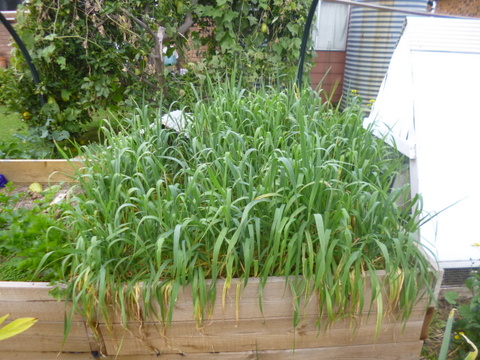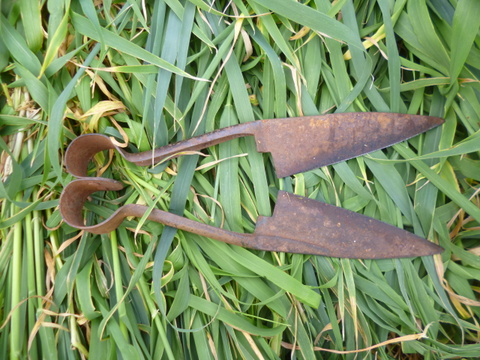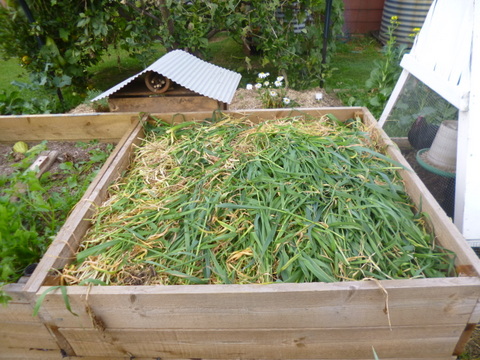I don’t use green manure that much to keep by beds fertile, not because it is a bad idea but because there is no prolonged fallow period in my rotation where it would be practical to fit it in. Green manure is a great idea though and a good organic way to maintain fertility. The idea is to sow a mixture of legumes and annual grains and vegetables, let them grow up but before they flower cut them down and either dig them in or leave them on the surface to rot down.
The benefits of including a green manure in your backyard veggie rotation include –
- Deep minerals can be brought to the surface, for use by later crops.
- Increased levels of nitrogen (from legumes) and carbon (from the grains and vegetables) in the soil.
- Increased soil organic matter.
- Break disease cycles by totally changing crops grown.
- The soil is loosened enabling air, roots and water easier and deeper penetration.
- Keeps the soil covered when nothing else is being grown, keeping the soil temperature down and supporting soil life.
To get the best out of your green manure crop it needs to be grown quickly and well, so don’t sow it into dry sand and expect it to fix everything. There needs to be residual fertility in the soil for the green manure to capitalise on and it needs to be watered regularly to ensure the lush growth that will allow you to get the most out of it.
Choose the species which will make up your green manure so that they will grow well in your area and grow well at the time of year you want your green manure to grow. There are a wide variety of plants which can be used as green manure, so choose a mix of species and each will contribute their particular goodies to the soil.
Choosing your Species
As mentioned above a mix of species is desirable with some nitrogen fixers and some other species mixed in, appropriate to the time of year you want to plant your green manure. Below is a list of species to help your design your mix -
Autumn/Winter – nitrogen fixers (Legumes)
Broad Beans, Dun pea, Fenugreek, Lucerne, Lupins, Peas, Red Clover, Subterranean Clover, White Clover, Vetch.
Autumn/Winter – grains & vegetables
Barley, beet, buckwheat, corn salad, dill, endive, Japanese millet, kale, linseed, oats, purslane, radish, rapeseed (Canola), rocket, rye, spinach, turnip, wheat, white mustard.
Spring/Summer – Nitrogen Fixers (Legumes)
Broad beans, cowpea, fenugreek, medic, mung beans, soybeans, vetch
Spring/Summer – grains & vegetables
Basil, beet, buckwheat, coriander, dill, endive, Japanese millet, mustard, purslane, radish, rocket, turnip, wheat, white millet.
What I did
As previously mentioned, I don’t use green manure much but one of my wicking beds came free after a good crop of potatoes. Potatoes are gross feeders and I need to replenish the soil but on top of that the “organic mix” I had filled the wicking bed with was somewhat less satisfactory than I had hoped. While it was free draining it did seem to be lacking in nitrogen and perversely enough, organic matter. It dried out quickly, wicking bed or no wicking bed. A quick top dress with chook poo produced a good potato crop but now was the time to correct the problem properly.
I went through and removed any residual tiny spuds (I’m sure I missed a few) then threw on a couple of bags of mushroom compost and worked them through the top 100mm – 150mm of the bed with a small hand hoe. Once I was happy with that I broadcast sowed the green manure mix, usual seeding rate is 10gms - 20gms per square metre but I wanted a thick coverage so I put on somewhat more than that. With the seed sown I top dressed the bed with a thin layer of compost and then watered the living daylights out of it to ensure germination.
Germination rates were good and before long I had a healthy, lush growth of green stuff covering the top of the bed. I left it grow for several months and just as the oats were preparing to flower I cut the plants back to almost ground level with a pair of hand shears, leaving the cut material on the ground as mulch. You can do this several times to increase the level of organic matter but I only wanted to do it once before replanting, so after a few days I wound up uprooting the plant material still in the ground to prevent it from re-growing. On a large scale it would be ploughed or rotary hoed in.
The result has been more fertile soil and, as a result, happier plants.






